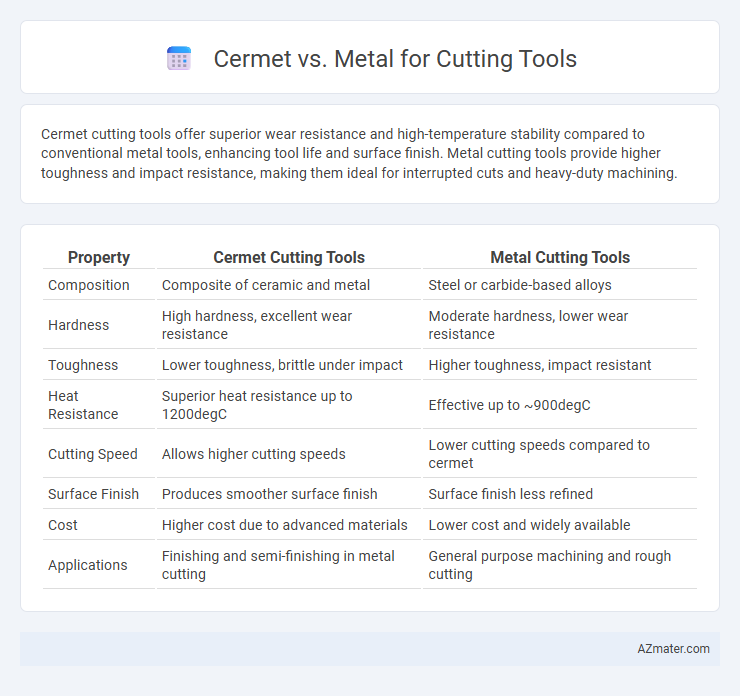Cermet cutting tools offer superior wear resistance and high-temperature stability compared to conventional metal tools, enhancing tool life and surface finish. Metal cutting tools provide higher toughness and impact resistance, making them ideal for interrupted cuts and heavy-duty machining.
Table of Comparison
| Property | Cermet Cutting Tools | Metal Cutting Tools |
|---|---|---|
| Composition | Composite of ceramic and metal | Steel or carbide-based alloys |
| Hardness | High hardness, excellent wear resistance | Moderate hardness, lower wear resistance |
| Toughness | Lower toughness, brittle under impact | Higher toughness, impact resistant |
| Heat Resistance | Superior heat resistance up to 1200degC | Effective up to ~900degC |
| Cutting Speed | Allows higher cutting speeds | Lower cutting speeds compared to cermet |
| Surface Finish | Produces smoother surface finish | Surface finish less refined |
| Cost | Higher cost due to advanced materials | Lower cost and widely available |
| Applications | Finishing and semi-finishing in metal cutting | General purpose machining and rough cutting |
Introduction to Cutting Tool Materials
Cermet cutting tools combine ceramic and metallic materials to offer enhanced wear resistance and high-temperature stability compared to traditional metal tools such as high-speed steel and carbide. Metal cutting tools provide toughness and impact resistance but often lack the hardness and thermal stability found in cermets, making cermets ideal for high-speed machining and precision finishing. Selecting cutting tool materials depends on machining conditions, desired tool life, and workpiece material compatibility.
Overview of Cermet Cutting Tools
Cermet cutting tools combine ceramic and metallic materials, offering superior wear resistance and high-temperature stability compared to traditional metal tools. These tools excel in precision machining of hard materials, providing enhanced surface finish and longer tool life. Their composition allows for reduced cutting forces and improved thermal conductivity, making them ideal for high-speed cutting applications.
Properties of Metal Cutting Tools
Metal cutting tools require high hardness, toughness, and thermal stability to withstand intense friction and heat during machining. Cermet tools offer superior wear resistance and maintain hardness at elevated temperatures due to their ceramic-metal composite structure, while metal tools, typically made from high-speed steel or carbide, provide better toughness and impact resistance. The choice between cermet and metal tools depends on the specific machining application, balancing cutting speed, tool life, and material compatibility.
Wear Resistance: Cermet vs Metal
Cermet cutting tools exhibit superior wear resistance compared to traditional metal tools, primarily due to their ceramic particles that provide enhanced hardness and thermal stability. This elevated wear resistance allows cermet tools to maintain sharpness and cutting precision over extended periods, reducing tool replacement frequency. In contrast, metal tools, while tougher, tend to experience faster wear and deformation under high-temperature and abrasive conditions.
Heat Resistance and Thermal Stability
Cermet cutting tools exhibit superior heat resistance and thermal stability compared to metal tools, allowing them to maintain hardness and sharpness at elevated temperatures up to 900degC. Metal cutting tools, typically made from high-speed steel or carbide, demonstrate lower thermal stability, often losing hardness when exposed to prolonged high-temperature cutting conditions above 700degC. Enhanced heat resistance of cermet tools contributes to longer tool life and better surface finish in high-speed machining applications.
Machining Performance and Surface Finish
Cermet cutting tools exhibit superior wear resistance and maintain hardness at elevated temperatures, leading to enhanced machining performance in high-speed cutting applications compared to conventional metal tools. Their fine-grained structure enables the production of a smoother surface finish and tighter dimensional tolerances, reducing the need for secondary finishing processes. Metal tools, often composed of high-speed steel or carbide, offer toughness and impact resistance but generally produce rougher surfaces and wear faster under similar cutting conditions.
Tool Life Comparison: Cermet and Metal
Cermet cutting tools exhibit superior wear resistance and hot hardness compared to conventional metal tools, resulting in significantly longer tool life under high-speed machining conditions. Metal tools, particularly high-speed steel (HSS) and cobalt alloys, tend to wear faster due to lower thermal stability and hardness at elevated temperatures. The enhanced tool life of cermet materials translates to reduced downtime and lower overall tooling costs in industrial applications.
Application Suitability and Industry Use Cases
Cermet cutting tools excel in high-speed machining applications involving fine finishing and precision work due to their superior hardness and wear resistance, particularly in aerospace and automotive industries. Metal cutting tools, especially carbide and high-speed steel variants, are favored for their toughness and versatility in roughing operations and medium to heavy-duty machining across general manufacturing and construction sectors. Choosing between cermet and metal tools depends on factors like material hardness, machining speed, and desired surface finish, influencing productivity and tool life in specific industrial use cases.
Cost Analysis: Cermet vs Metal Tools
Cermet cutting tools typically have a higher initial purchase cost compared to conventional metal tools due to advanced ceramic-metal composite materials and manufacturing processes. However, cermet tools often provide longer tool life and better wear resistance, potentially lowering overall operational costs in high-precision or high-speed machining. In contrast, metal tools, particularly high-speed steel and carbide variants, offer lower upfront expenses but may require more frequent replacement and maintenance, impacting total cost efficiency over time.
Choosing the Right Cutting Tool Material
Cermet cutting tools offer superior hardness and wear resistance compared to traditional metal tools, making them ideal for high-speed machining of hardened steels and cast irons. Metal cutting tools, often made from high-speed steel or carbide, provide better toughness and impact resistance, suitable for interrupted cuts and heavy-duty operations. Choosing the right cutting tool material depends on the workpiece hardness, machining speed, and application-specific demands to balance tool life and performance effectively.

Infographic: Cermet vs Metal for Cutting tool
 azmater.com
azmater.com